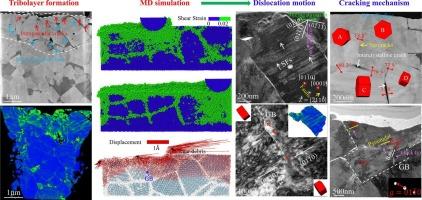干滑动条件下WC-Co硬质合金表面位错行为及开裂机制
IF 4.6
2区 材料科学
Q2 MATERIALS SCIENCE, MULTIDISCIPLINARY
International Journal of Refractory Metals & Hard Materials
Pub Date : 2025-08-14
DOI:10.1016/j.ijrmhm.2025.107374
引用次数: 0
摘要
表面碳化钨(WC)和钴(Co)成分的变形过程和应变传递机制显著影响硬质合金的摩擦学性能。然而,在摩擦应力作用下,控制硬质合金塑性变形和裂纹萌生和剥落的机制尚不清楚。本研究采用聚焦离子束(FIB)微加工技术,从硬质合金干滑动过程中产生的摩擦层制备透射电子显微镜(TEM)片层。随后利用透射电镜(TEM)和透射菊池衍射(TKD)观察了摩擦层内的微观结构响应和位错滑移系统。此外,描述了摩擦引起的原子位移,并利用分子动力学(MD)模拟阐明了应变传递机制。结果表明:位错主要在棱柱形(011¯0)或锥体(011¯1)平面上滑移,WC晶粒取向与滑移方向之间的角关系决定了具体的滑移面,a(b=1/3112¯0)位错主要被激活。WC晶内裂纹的萌生与锥面位错的运动密切相关。然而,晶间裂纹通常起源于沿基面0001沿高角度晶界扩展。该研究为设计具有优异的地下弹塑性适应性的耐磨硬质合金提供了理论基础。本文章由计算机程序翻译,如有差异,请以英文原文为准。

Dislocation behavior and cracking mechanisms at the WC-Co cemented carbide surface under dry sliding conditions
The deformation processes and strain transfer mechanisms within the tungsten carbide (WC) and cobalt (Co) components at the surface significantly influence the tribological performance of cemented carbides. Nevertheless, the mechanisms governing plastic deformation and the initiation and spallation of cracks under frictional stresses in cemented carbides are obscure. This study employed focused ion beam (FIB) micromachining techniques to fabricate transmission electron microscopy (TEM) lamellae from the tribolayer, which arises during the dry sliding of cemented carbides. The microstructural response and dislocation slip systems within the tribolayer were subsequently scrutinized using TEM under two-beam conditions and transmission Kikuchi diffraction (TKD). Moreover, friction-induced atomic displacements were delineated and the strain transfer mechanisms were elucidated using molecular dynamics (MD) simulations. The results indicated that dislocations primarily slipped on prismatic or pyramidal planes, with the angular relationship between the orientation of the WC grain and sliding direction determining the specific slip plane and the ) dislocations being primarily activated. The initiation of intragranular cracks in WC was closely linked to the motion of dislocations on the pyramidal planes. However, intercrystalline cracks typically originate and propagate along the basal planes at high-angle grain boundaries. This study provides a theoretical foundation for designing wear-resistant cemented carbides characterized by exceptional subsurface elastoplastic adaptability.
求助全文
通过发布文献求助,成功后即可免费获取论文全文。
去求助
来源期刊
CiteScore
7.00
自引率
13.90%
发文量
236
审稿时长
35 days
期刊介绍:
The International Journal of Refractory Metals and Hard Materials (IJRMHM) publishes original research articles concerned with all aspects of refractory metals and hard materials. Refractory metals are defined as metals with melting points higher than 1800 °C. These are tungsten, molybdenum, chromium, tantalum, niobium, hafnium, and rhenium, as well as many compounds and alloys based thereupon. Hard materials that are included in the scope of this journal are defined as materials with hardness values higher than 1000 kg/mm2, primarily intended for applications as manufacturing tools or wear resistant components in mechanical systems. Thus they encompass carbides, nitrides and borides of metals, and related compounds. A special focus of this journal is put on the family of hardmetals, which is also known as cemented tungsten carbide, and cermets which are based on titanium carbide and carbonitrides with or without a metal binder. Ceramics and superhard materials including diamond and cubic boron nitride may also be accepted provided the subject material is presented as hard materials as defined above.

 求助内容:
求助内容: 应助结果提醒方式:
应助结果提醒方式:


